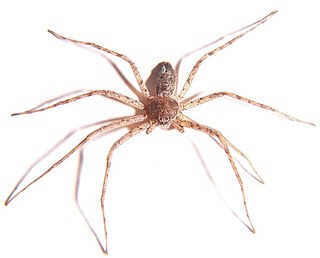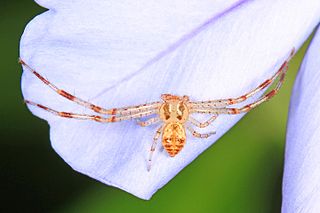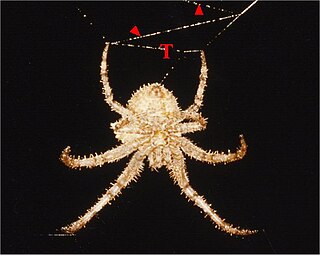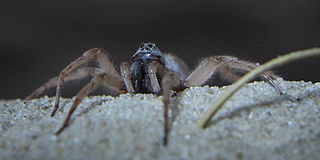
Ground spiders comprise Gnaphosidae, the seventh largest spider family with over 2,000 described species in over 100 genera distributed worldwide. There are 105 species known to central Europe, and common genera include Gnaphosa, Drassodes, Micaria, Cesonia, Zelotes and many others. They are closely related to Clubionidae. At present, no ground spiders are known to be seriously venomous to humans.

Philodromidae, also known as philodromid crab spiders and running crab spiders, is a family of araneomorph spiders first described by Tord Tamerlan Teodor Thorell in 1870. It contains over 500 species in thirty genera.

A bolas spider is a member of the orb-weaver spider that, instead of spinning a typical orb web, hunts by using one or more sticky "capture blobs" on the end of a silk line, known as a "bolas". By swinging the bolas at flying male moths or moth flies nearby, the spider may snag its prey rather like a fisherman snagging a fish on a hook. Because of this, they are also called angling or fishing spiders. The prey is lured to the spider by the production of up to three sex pheromone-analogues.

Misumenops is a common genus of crab spider with more than 50 described species.

Misumenoides is a genus of spiders in the family Thomisidae. Spiders in this family are commonly called "crab" or "flower" spiders.

Castianeira is a genus of ant-like corinnid sac spiders first described by Eugen von Keyserling in 1879. They are found in Eurasia, Africa, and the Americas, but are absent from Australia. Twenty-six species are native to North America, and at least twice as many are native to Mexico and Central America.

Lycosa is a genus of wolf spiders distributed throughout most of the world. Sometimes called the "true tarantula", though not closely related to the spiders most commonly called tarantulas today, Lycosa spp. can be distinguished from common wolf spiders by their relatively large size. This genus includes the European Lycosa tarantula, which was once associated with tarantism, a dubious affliction whose symptoms included shaking, cold sweats, and a high fever, asserted to be curable only by the traditional tarantella dance. No scientific substantiation of that myth is known; the venom of Lycosa spiders is generally not harmful.

Micrathena, known as spiny orbweavers, is a genus of orb-weaver spiders first described by Carl Jakob Sundevall in 1833. Micrathena contains more than a hundred species, most of them Neotropical woodland-dwelling species. The name is derived from the Greek "micro", meaning "small", and the goddess Athena.

Hogna is a genus of wolf spiders with more than 200 described species. It is found on all continents except Antarctica.

Kaira, sometimes called frilled orbweavers, is a mostly neotropical genus of orb-weaver spiders first described by O. Pickard-Cambridge in 1889. It includes sixteen described species that occur from South America up to the southern and eastern USA. It is presumably related to Aculepeira, Amazonepeira and Metepeira.

Allocosa is a spider genus of the wolf spider family, Lycosidae. The 130 or more recognized species are spread worldwide.

Eustala is a genus of orb-weaver spiders first described by Eugène Simon in 1895.

Mecynogea is a genus of orb-weaver spiders first described by Eugène Simon in 1903. The name is derived from the Greek mekyno (μηυνω), meaning "to lengthen", and "gea" (γεα), meaning "earth".

Trachelopachys is a genus of South American araneomorph spiders first described by Eugène Simon in 1897. Originally placed with the Corinnidae, it was moved to the Trachelidae in 2014.

Cyrtarachninae is a subfamily of spiders in the family Araneidae. The group has been circumscribed in several different ways. It originated as the group Cyrtarachneae, described by Eugène Simon in 1892. The group was later treated at different ranks: as a tribe, both under Simon's name and as Cyrtarachnini, and as the subfamily Cyrtarachninae. Circumscriptions have varied. The broadest circumscription, Cyrtarachninae sensu lato (s.l.), includes three of Simon's original groups, including the bolas spiders. Unlike most araneids, members of the subfamily do not construct orb webs, some not using webs at all to capture prey, some using one or more sticky drops on a single line, while others construct webs with few widely spaced non-spiral threads, some triangular. Many have been shown to attract prey by producing analogues of insect sex pheromones, particularly to attract male moths. Adult females may mimic snails, bird droppings and other objects, and so are able to remain exposed during the day time, capturing prey at night.
Mastophora extraordinaria is a species of spider in the orb-weaver spider family Araneidae. It is found in South America. Like some other species of the genus Mastophora, adult females resemble bird droppings. Mastophora species, including M. extraordinaria, are "bolas spiders" – adult females capture their prey by using a sticky drop on the end of a single line which they swing at the target, usually a male moth attracted by the release of an analogue of the attractant sex pheromone produced by the female moth. Juveniles and adult males do not use a bolas, catching prey with their legs alone.

















